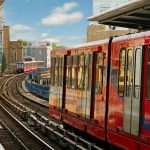Pipe paints a sobering picture of the pandemic’s impact on Central London. First and foremost, he stresses, it is “crucial to recognise the profound impact it’s had on Londoners’ lives”. He goes on to freely acknowledge that the CAZ area’s economic recovery remains somewhat sluggish and presents particular challenges. All of which might sound like rather heavy fare to start a conversation about recovery, but Pipe remained positive, even as he reeled off some pretty grim statistics. It soon enough became clear why.
Pipe points to GLA-commissioned research – more of which is in the pipeline – confirming that the CAZ economy’s traditional dependence on commuters and tourists (domestic but especially international) “is an issue”. London’s recovery more generally remains “a percentage point or more worse than the rest of the country” on many key metrics and the CAZ area’s economy continues to be disproportionately affected, for no reason other than “the nature of its local economy”, which makes it “particularly sensitive” to the type of shock caused by lockdowns and other restrictions.
But here’s “the good news”. Activity in the CAZ has been “picking up” since the easing of restrictions, with steadily rising employment rates and falling benefits claimant rates suggesting that Londoners are getting back to work in ever-greater numbers. Similarly, “domestic tourism is beginning to make a real difference in Central London – and when we get international tourism back [to pre-pandemic numbers] that will make a factor of five difference”.
But, above and beyond economic performance in the here and now, Pipe has absolute faith in London’s “many intrinsic strengths”, which provide the “real reasons to remain optimistic”. Aside from wider factors such as English being a global language of trade and the country’s business-friendly legal and regulatory system, he lists several “attractions” specific to London. These include its relative safety, the concentration of global higher education institutions in the city centre, the quality of its primary and secondary schools, its ample green spaces, and its unparalleled cultural offer.
All of which means that Central London remains a hugely popular place for businesses to base themselves. “We are constantly seeing new agglomerations of businesses that are drawn in by those attractions” he says, pointing to how the likes of Google, Facebook and Apple plan to expand their footprint in the city and to the proliferation of new businesses and projects in sectors like fintech and the life sciences. But, “nascent” industries aside, traditional CAZ sectors including food and hospitality are also “coming back with a vengeance” after the forced hibernation of lockdown.
“We want to be supportive of all that” says Pipe, who stresses that the Mayor is committed to delivering on a manifesto promise of being London’s “most business-friendly Mayor” – but also and perhaps even more importantly, to “building back better, greener and fairer, taking into account the lessons we have learned over the past 18 months”.
Indeed, Pipe is very much of the view that many of the pandemic’s worst impacts lie in “exacerbating” existing economic, social and health disparities. Pointing to the London Plan specifically, he contends that the Mayor’s flagship spatial planning policy already highlighted the importance of amenities that COVID-19 elevated to essentials, from accessible open spaces, to minimum space standards and even the availability of workspace within new homes – “it was all there in Mayoral policy, before, during and after COVD”.
Asked about how City Hall is seeking to support property development in the CAZ specifically, Pipe again cites the London Plan, as “very supportive of the CAZ” and something that “has been followed through with very positive development decisions by the Mayor”. He also stresses that Deputy Mayors including himself, Tom Copley (Housing), Rajesh Agrawal (Business), Justine Simons (Culture) and others play a key role – as ambassadors “banging the drum” for London as an investment destination at public events including MIPIM, as spokespeople for what the Mayor expects of the sector and as sounding boards for the industry’s needs and concerns.
Pipe also notes that City Hall is “doing a lot of research, as well as medium and long-term planning, for the transformation of key districts”. It is “working very closely with all business groups, whether it’s the WPA and CPA, London First or others” as well as – increasingly – with Business Improvement Districts. Working also with local boroughs, TfL and Network Rail, the GLA is seeking to achieve “better coordination and sequencing” of development around key central transport hubs including Waterloo, Victoria and of course Euston, “another big opportunity”. The GLA and TfL are also very keen to continue working with landowners across the entire length along Elizabeth Line, particularly around stations including Tottenham Court Road and Farringdon.
Talk of Crossrail and over-station development naturally brought us to issue of often frosty relations between City Hall and Whitehall – and the seemingly persistent rift over funding for Transport for London. Here, Pipe is decidedly sombre. He acknowledges that, especially in the period leading up to the May 2021 elections – which saw Khan re-elected for a second term – things were “difficult”, certainly in public. But he also notes that, beyond the headlines and behind the scenes, “work always continues, meetings happen and things are always civil”. Pipe further offers assurances that the Mayor and his team are very open about renewing efforts to “build bridges”, not only with Whitehall, but with local government in London and in other parts of the country.
All the above aside, he says, “we really need Government to work with us in the same spirit”. Pipe argues forcefully that the Government’s focus on “being seen paying attention to the north mustn’t be followed by a weakening of attention on London”. He also rejects, as nothing less than “preposterous”, suggestions that TfL’s financial shortfall can simply be filled by better financial management or cutting down on payroll and benefits. He goes on underline that TfL “relies more on its fare-box than any other global city in the world” and to lay out City Hall’s case for a more sustainable, long-term financial settlement from Government, following a series of short-term so-called “bailout” packages – a case that will be familiar to our blog’s readers.
It is however worth highlighting Pipe’s strongly-held belief that financial certainty for TfL is critical to recovery – for the CAZ, London more generally and indeed the country as a whole. “Everything that we’ve discussed so far”, he says, “from the ability of theatres and restaurants to survive, to the attractiveness of London as a place to locate businesses, and the return of tourism – it is all determined by two things: the feeling of safety and the ability to get around in a clean, reliable transport system”. Financial certainty for TfL is therefore nothing less than “the number one thing for London’s continued success”.
He frames a failure to provide that certainty starkly, in terms of “the break that it will apply on development”. He says that proposed projects like the Bakerloo Line extension for the Old Kent Road, a new rail station for Beam Park, and a DLR extension to Thamesmead are absolutely critical to those areas accommodating growth. Pipe warns that on the Old Kent Road in particular, we are fast approaching a “mad situation, where significant developments are permissioned, but with a Grampian condition on them, that they can’t be built out until there’s signs of progress on the Bakerloo Line”.
Pipe ominously argues that, without Government investment in these and other projects, Crossrail “could be the last major transport investment in London for 10-15 years, because the planning of the next things has been mothballed; there isn’t even the cash to have planning teams work on safeguarding sites and so on – let alone start work on the actual engineering of them”.
While on the subject of long-term certainty, we find ourselves discussing still-paused national planning reforms. Pipe is remarkably sanguine about it all. Engagement with Whitehall has been “reasonably reassuring”, producing “no indication that there was going to be an undermining of Mayoral authorities” generally, nor of “anything that particularly sidelined the Mayor of London” specifically. He is also encouraged by signs that proposals for a new zoning-based system that would have restricted the role of planning committees have “rolled away” and that the incoming Secretary of State also seems to be “stepping away” from other controversial proposals. Whatever the changes brought in by the forthcoming Planning Bill, Pipe is confident that these would have “long lead-in times” meaning that even with the original timelines set out by Government, the current London Plan should have had a “good run” until an already-planned review starting in 2026.
Pipe does however remain apprehensive about proposals for a single infrastructure levy that “kludges together” all developer contributions, including affordable housing, calling it a “bad idea” and one that “everyone is against”. He is even less happy about already-implemented reforms to permitted development rights (PDR), arguing that this is another policy that one “can’t find anyone who is in favour of, apart from some small landlords” and that “if you have the Mayor and the British Property Federation singing from the same hymn-sheet on such an issue, something must be up”. Pipe contends that the new PDRs “undermine” the London Plan and restricts the ability of authorities to work effectively with landowners to “curate” town centres.
Returning to the question of recovery, Pipe emphasises that “restoring confidence in the city” is a top priority for City Hall – and that the dedicated London Recovery Board is a key tool for achieving this, as is London & Partners, the capital’s promotional agency. He underlines that the latter remains integral to promoting London as a place to visit and as a place to invest in. Pipe highlights the Let’s Do London domestic tourism campaign – the “biggest ever” of its kind – as an example of what the Mayor can achieve in this area, citing estimates that it has produced a tenfold return on investment, particularly for the CAZ’s visitor economy.
Ultimately, he says, the key to addressing the CAZ area’s weaknesses – and the ultimate purpose of all relevant policy, political decision-making and investment – lies in “improving its offer, to Londoners, to the nation and to the world” and in ensuring that it remains an attractive place to live, work and invest in – a London that people “want to come to, even if they don’t have to”.
This interview was conducted by London Communications Agency on behalf of the London Property Alliance as part of its curation of the monthly Central London Planning & Politics newsletter.
Read more from our London Leaders series here.


